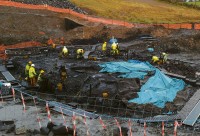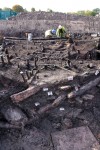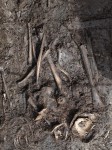 The archaeological excavation of Drumclay Crannog in County Fermanagh, Ulster, which was scheduled to end on December 30th has been extended another three months. Minister of the Environment Alex Attwood granted the extension to give archaeologists time to dig through the earliest layers of occupation of the artificial island before a link road is built through it.
The archaeological excavation of Drumclay Crannog in County Fermanagh, Ulster, which was scheduled to end on December 30th has been extended another three months. Minister of the Environment Alex Attwood granted the extension to give archaeologists time to dig through the earliest layers of occupation of the artificial island before a link road is built through it.
The road almost destroyed the crannog before it had the chance to showcase its thousand years of history. The construction company sponsored a single trench excavation that confirmed its archaeological richness and then planned to continue to build the road ostensibly preserving the crannog in situ. It should come as little surprise that this plan turned out to be unworkable because the road construction altered the water balance and damaged the structure of the island. Buckling outwards and drying out at a precipitous rate, the crannog had to be excavated before it was lost forever.
The first round of excavations began in June. They were done by woefully undersupplied contract archaeologists and scheduled to last just six weeks. The archaeologists leaked the woeful story to bloggers and the media and the subsequent ruckus resulted in the Environment Minister getting personally involved, appointing additional experts and extending the dig another two months. Then the dig was extended another three months, and now three more months again.
The minister explained why he was preserving the site for longer.
“It will reshape national and international thinking on crannogs and the lives of people stretching back 1,300 years at least,” he said. “A unique moment requires a unique approach. That is why the dig is being extended another three months.
“This is the first substantial scientific excavation of a crannog in Northern Ireland. What has been found will ultimately lead to a reassessment of life in Ulster in Early Christian and medieval times. It is of international importance.
“Given all of that, it is important that we maximise the opportunity to unveil as much of our rich heritage here as possible. That is why I am extending the period in which archaeologists can dig.”
 It’s the crannog’s unique wealth of artifacts and structures beautifully preserved by thousands of years in a bog that have saved its archaeological life. It has revealed itself to be an exception source about daily life in medieval and early Christian Ireland, a period for which there is little documentation to help us understand the lives of people who didn’t make the headlines.
It’s the crannog’s unique wealth of artifacts and structures beautifully preserved by thousands of years in a bog that have saved its archaeological life. It has revealed itself to be an exception source about daily life in medieval and early Christian Ireland, a period for which there is little documentation to help us understand the lives of people who didn’t make the headlines.
In this case, those people were generations of a well-off extended family who lived in several houses with servants and live stock. They made textiles from their sheep’s wool, butchered their own meat, carved wood for work tools, log boats, homes and board games. Some of the objects show stylistic influences from elsewhere in Europe which suggest these people living on a small island they built in the middle of a lake in Ulster had wider trade connections than anybody expected them to.
 So far archaeologists have unearthed evidence of occupation from at least 900 A.D. to 1600, but they think there are at least another 300 more years layered underneath that. The most recent find is a woodcutting axe from the 9th century. The additional time will hopefully reveal the earliest occupation of the crannog before road work commences again and the island disappears forever.
So far archaeologists have unearthed evidence of occupation from at least 900 A.D. to 1600, but they think there are at least another 300 more years layered underneath that. The most recent find is a woodcutting axe from the 9th century. The additional time will hopefully reveal the earliest occupation of the crannog before road work commences again and the island disappears forever.
The dig has captured the attention of local residents and people around the world. When the crannog dig had an open day on December 1st, 600 people visited the excavation between 9:30 AM and 3:00 PM. Minister Attwood hopes to hold more public viewing days during the next months, and in the long term, to turn this discovery into a source of much-needed tourist cash.
Appreciate your efforts on this blog
Myles Raucher